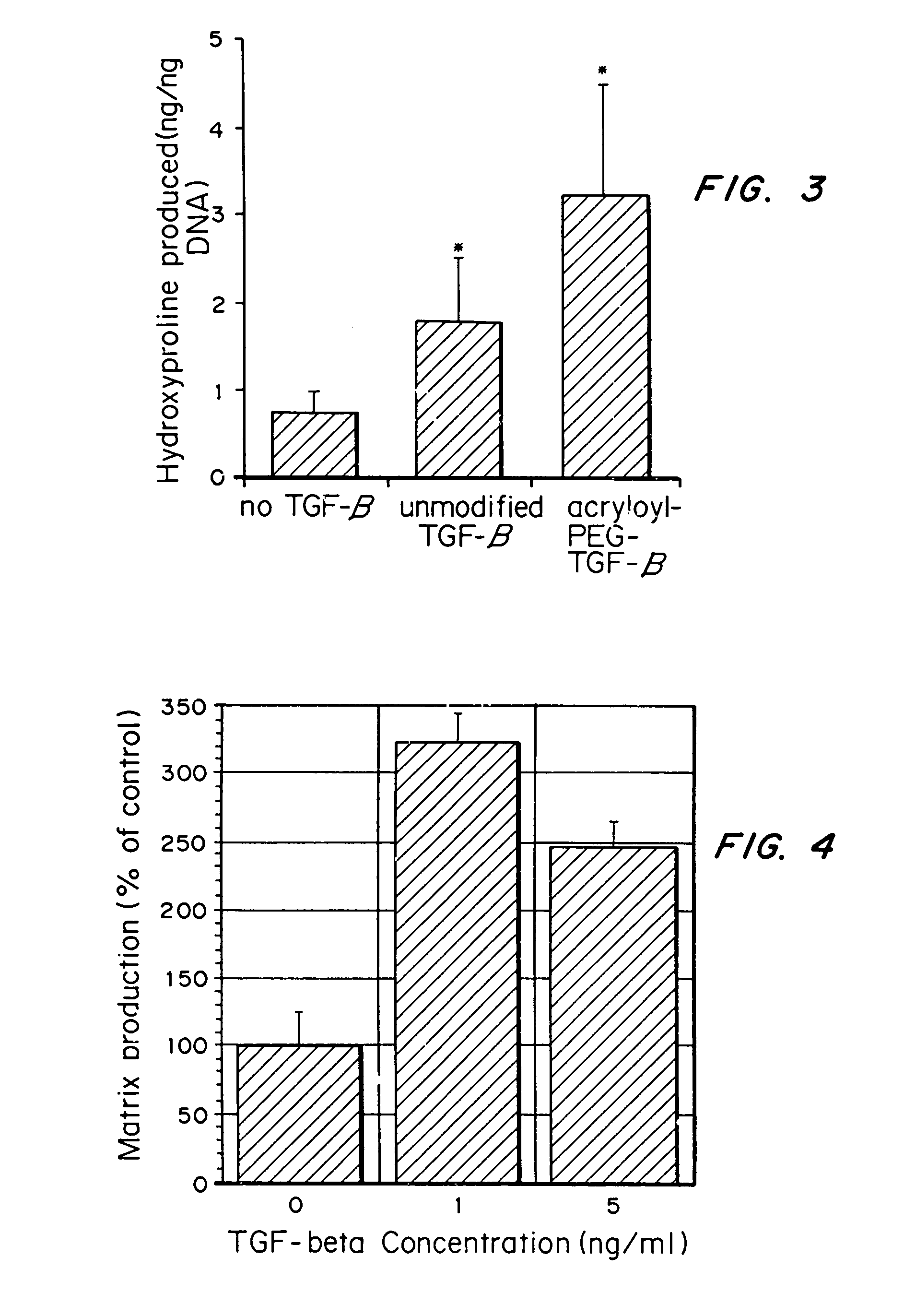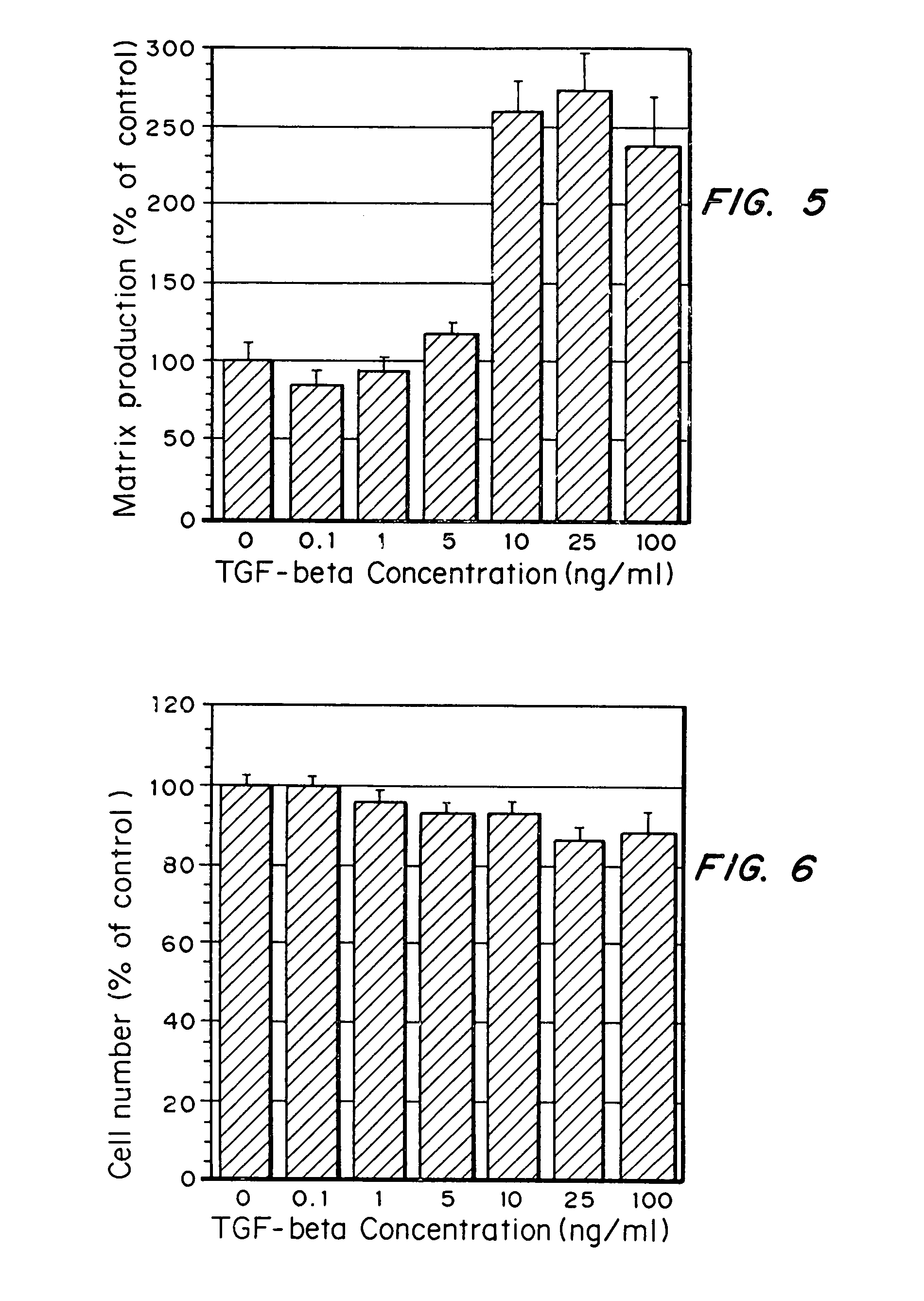Tissue engineering scaffolds promoting matrix protein production
a technology of matrix protein and tissue engineering, which is applied in the field of tissue engineering scaffolds promoting matrix protein production, can solve the problems of reducing the structural integrity of the developing tissue, adversely affecting ecm production, and increasing cell adhesion, so as to increase ecm production, maintain the integrity of the scaffold, and increase the effect of ecm production
- Summary
- Abstract
- Description
- Claims
- Application Information
AI Technical Summary
Benefits of technology
Problems solved by technology
Method used
Image
Examples
example 1
Comparison of Effect of Soluble and Bound TGF-β in Combination with PEG-Diacrylate Hydrogel
[0043]It was determined whether TGF-β can counteract the decrease in ECM synthesis caused by immobilized cell adhesion ligands. SMCs were grown on both peptide-modified glass substrates and in hydrogels containing tethered cell adhesion ligands. Further, TGF-β was covalently tethered to a polymer scaffold and shown that it retains its ability to increase ECM production.
[0044]Materials & Methods
[0045]Cell Maintenance
[0046]Chemicals were obtained from Sigma Chemical Co. (St. Louis, Mo.) unless otherwise stated. SMCs from the thoracic aorta of Wistar-Kyoto rats were isolated and characterized as previously described by Scott-Burden, et al., Hypertension 13:295-305 (1989). Human aortic smooth muscle cells (HASMCs) were obtained from Clonetics (San Diego, Calif.). Both SMCs and HASMCs were maintained on Minimal Essential Medium Eagle supplemented with 10% fetal bovine serum (FBS; BioWhittaker, Walk...
example 2
Dose Response of Aortic Smooth Muscle Cells to TGF-β
[0074]Aortic smooth muscle cells were grown on aminophase glass that had 0.5 nmol / cm2 RGDS (SEQ ID NO:1) covalently coupled to the glass. TGF-β was added to the media at 0, 1, or 5 ng / ml (0, 4×10−5, 2×10−4 nmol / ml). ECM protein production by the cells over a 2-day time period was determined by examining the amount of 3H-glycine incorporated into the ECM elaborated by the cells.
[0075]As seen in FIG. 4, ECM protein production per cell (% of control) was increased when TGF-β was added to the media at both 1 and 5 ng / ml. Further, cell numbers did not increase over the 2 days, despite changes in matrix production per cell, indicating that the presence of TGF-β did not increase proliferation of the SMCs, as seen in the hydrogels.
example 3
Dose Response of Auricular Chondrocytes to TGF-β
[0076]Auricular chondrocytes were grown on tissue culture polystyrene with varying amounts of TGF-β added to the media: 0, 1, 5, 10, 25, or 100 ng / ml. ECM protein production by the cells over a 2-day time period was determined by examining the amount of 3H-glycine incorporated into the ECM elaborated by the cells.
[0077]As seen in FIG. 5, ECM protein production per cell was increased when TGF-β was added to the media at concentrations above 1 ng / ml, with an optimal concentration of 25 ng / ml (1×10−3 nmol / ml). Further, cell numbers did not increase over the 2 days (see FIG. 6), despite changes in matrix production per cell, indicating that the presence of TGF-β did not increase proliferation of the chondrocytes.
PUM
| Property | Measurement | Unit |
|---|---|---|
| Mass | aaaaa | aaaaa |
| Mass | aaaaa | aaaaa |
| Molar density | aaaaa | aaaaa |
Abstract
Description
Claims
Application Information
 Login to View More
Login to View More - R&D
- Intellectual Property
- Life Sciences
- Materials
- Tech Scout
- Unparalleled Data Quality
- Higher Quality Content
- 60% Fewer Hallucinations
Browse by: Latest US Patents, China's latest patents, Technical Efficacy Thesaurus, Application Domain, Technology Topic, Popular Technical Reports.
© 2025 PatSnap. All rights reserved.Legal|Privacy policy|Modern Slavery Act Transparency Statement|Sitemap|About US| Contact US: help@patsnap.com



